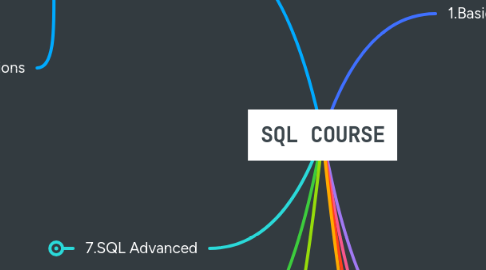SQL COURSE
por Anil araja


1. 6.SQL Functions
1.1. Aggregate Functions
1.1.1. COUNT( )
1.1.2. SUM( )
1.1.3. AVG( )
1.1.4. MAX( )
1.1.5. MIN( )
1.2. String Functions
1.2.1. CONCAT( )
1.2.2. LOWER( )
1.2.3. UPPER( )
1.2.4. TRIM( )
1.2.5. LENGTH( )
1.2.6. SUBSTRING( )
2. 7.SQL Advanced
2.1. GROUP BY
2.2. HAVING
2.3. Subquires
2.4. EXISTS & IN
3. 8.Modifying Data
3.1. INSERT
3.2. UPDATE
3.3. DELETE & TRUNCATE
4. 9. Defining Data
4.1. CREATE TABLE
4.2. ALTER TABLE
4.3. DROP TABLE
5. Advanced SQL
5.1. Window Functions
5.2. Sets Operators
5.2.1. UNION
5.2.2. UNION ALL
5.2.3. EXCEPT
5.2.4. INTERSET
5.3. Case Statement
5.4. NULL Functions
5.5. Date and Time Functions
5.6. Subquries
5.7. Common table Expression CTE
5.8. Views and Temp Tables
6. 1.Basic
6.1. Introduction to SQL
6.1.1. What Is Data ?
6.1.2. What is Information ?
6.1.3. What is Database ?
6.1.4. Diffrenece between SQL and NOSQL Database ?
6.1.5. What is DBMS?
6.1.6. What is SQL ?
6.1.7. How SQL Works ?
6.2. Why Learn SQL?
6.3. Database Concepts
6.4. SQL Table Concepts
6.5. SQL Commands
6.5.1. DDL
6.5.2. DQL
6.5.3. DML
6.5.4. DCL
6.5.5. TCL
6.6. SQL Elements
7. 2.Prepare the environment
7.1. Download & Install MySQL
7.2. MySQL Workbench :Tour in the Interface
7.3. Install Tutorial Database
7.4. SQL Coding Style
8. 3.Querying Data
8.1. SELECT
8.2. DISTINCT
8.3. ORDER BY
8.3.1. ASC
8.3.2. DESC
